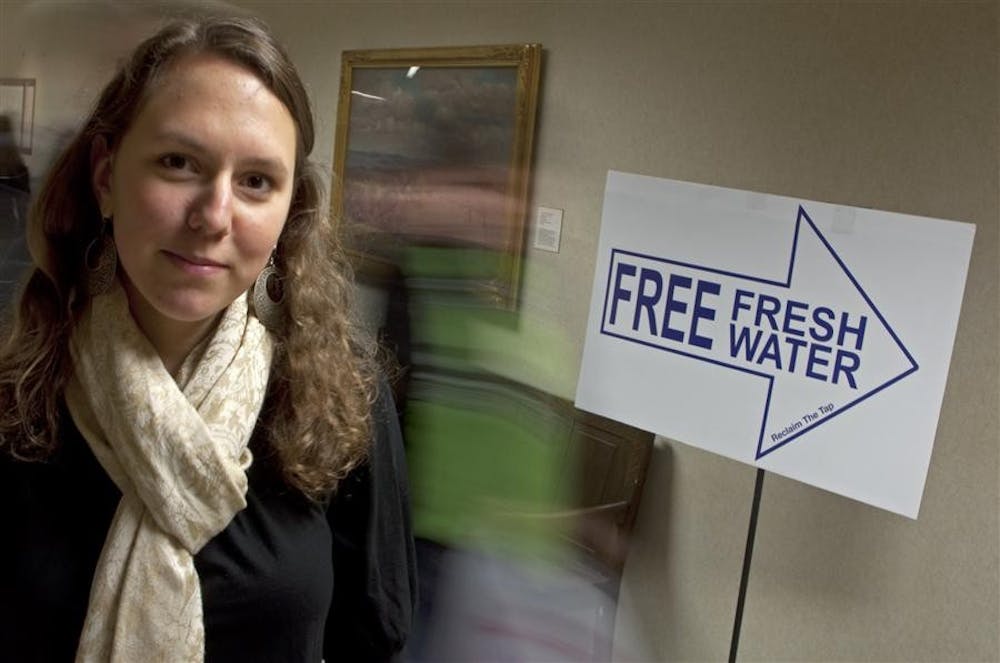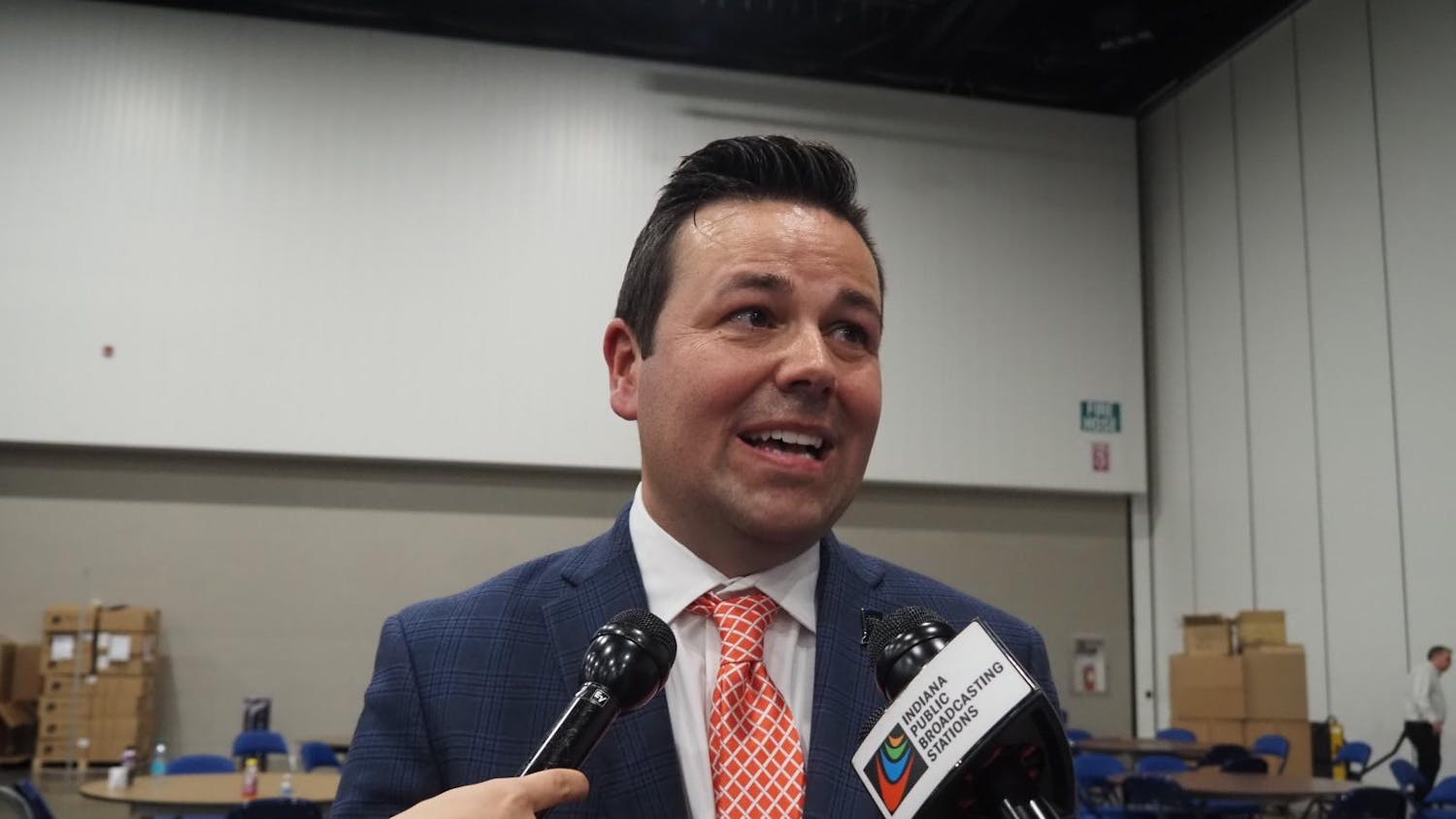As a sophomore with a major in studio art, Marine Tempels wants to help students take action against climate change and work toward a better, greener earth.
This semester she was given the chance to do just that.
But Tempels did not pass out a petition or coordinate a demonstration. There was no protest or rally. Instead, Tempels used the best weapon in her arsenal: a paintbrush.
As part of an eight-week course, “Engaged Art: Response and Intervention on Climate Change,” taught through the Henry Radford Hope School of Fine Arts, Tempels created a painting to raise awareness of the negative effects drinking bottled water can have on the environment.
Tempels’ painting is a mirror image of a Dasani water bottle at first glance, but a closer look reveals it’s true meaning.
The label of the bottle in the painting reads “Exceeds all federal, state and local guidelines, Tap Water, a product of Nature.”
When Tempels completed the painting, it was posted on a water fountain in the Indiana Memorial Union for any passersby to see. She also put up three large posters pointing toward other water fountains to promote “Free Water.”
“It was meant to bring awareness to the marketing tricks that water companies use to sell water back to us,” Tempels said.
But unexpectedly, the painting was not on display for long – it was stolen from its spot at the Union on Sunday night, only a week or so after being put up by IMU staff.
“It’s disappointing that the sign has been taken,” Tempels said. “Its message will no longer be able to be portrayed to large numbers of students.”
Tempels’ friend, sophomore Melissa Triplett, said she saw the “eye-catching” painting on the water fountain before it was stolen. It was upsetting, Triplett said, to hear it was no longer there.
“People are often disrespectful about property around campus that they should just leave alone,” Triplett said. “It shows that people don’t care about the message being put across and the idea that water bottles are harmful.”
Despite the setback, Tempels said she only sees herself moving forward with her involvement in environmental activism at IU, and that her art will play a major part in that involvement.
Tempels said she has been painting for her entire life but realized in high school that it was her passion.
And, although she came to IU with the intent of studying graphic design, she could not help but revert back to painting.
“I started going to lectures,” Tempels said. “I just couldn’t let go of painting. I liked it a lot more.”
But after classes ended her freshman year, Tempels read books, such as “An Inconvenient Truth: The Planetary Emergency of Global Warming and What We Can Do About It,” and watched “Planet Earth.” She became troubled and concerned by climate change.
By the recommendation of her advisor this fall, she decided to enroll in the “Engaged Art” course.
“It seemed like it fit me perfectly,” Tempels said. “I could mix the two things. I could use my art as a way to communicate problems.”
Instructors Edward Morris and Susannah Sayler required every student enrolled in the class to create artistic, environmental projects that would determine the bulk of their grade, to be determined on a final critique Dec. 4.
“It was good,” Sayler said. “We are doing it again this spring at another school. We’re excited about bringing the work we do to the classroom.”
Morris and Sayler are cofounders of The Canary Project, an organization dedicated to using art, photography and other artistic mediums to address climate change.
The organization had a show, titled “The Canary Project: Works on Climate Change 2006-2009” in the School of Fine Arts Gallery earlier this semester.
The students’ projects will be added to the organization’s collection of supported work, Sayler said. But, because the teachers have not been in Bloomington for the creation and implementation of the work, each student has been left on their own to document their progress.
“We read their journals every week,” Sayler said. “It’s a lot like being a parent, letting them work on their own.”
Tempels said Sayler and Morris were very helpful in the planning and research stages of her water bottle campaign, which she admitted took her longer to come up with the idea for than it did to actually implement it.
“There were so many different possible things you could aim for,” Tempels said. “I contacted the sustainability office and asked them what they thought needed to be addressed, and they said water bottles.”
Sayler said Tempels was very dedicated to her work, which made it stand out.
“She was very passionate and creative,” Sayler said. “We had a lot of back and forth with her figuring out what would work.”
In addition to taking the eight-week course, Tempels recently joined the Volunteers in Sustainability organization on campus.
“When Marine (Tempels) came and I heard about this project and her class, it was awesome,” Nathan Bower-Bir, senior and coordinator of the organization, said. “Bringing the information into the light through art is a cool way to do it.”
Bower-Bir said he thought the water bottle design of the painting was “really clever” and that it is a great addition to the Volunteers in Sustainability campaign.
“We’d like to print posters of it and put them on more water fountains,” Bower-Bir said.
Although he said he was saddened by the paintings disappearance, similar instances can always be motivating.
“It almost strengthens your desire to get out there and change minds,” Bower-Bir said. “Hopefully we can recreate her work and put it all over campus.”
Water Bottle Facts and Stats
Tap water is regulated by federal, state and local officials and Bloomington’s tap water exceeds all guidelines.
-Bloomington City Utilities Web site
“You could spend up to $1,050 annually on bottled water if you drank the equivalent of six glasses a day. The same amount of tap water would cost you 38 cents.”
-“Bottlemania : How Water Went on Sale and Why We Bought It” by Elizabeth Royte
“Between 1997 and 2008 U.S. consumption of bottled water grew 3,007 percent.”
-Elizabeth Royte
An estimated 40 percent of bottled water is tap water — sometimes further treated,
sometimes not.
-National Resources Defense Council
86 percent of bottled water ends up in landfills where they take thousands of years to decompose and leak their toxic components into the soil and water systems.
Only 14 percent are recycled.
-Food and Water Watch Organization
“Between 1990 and 1997, U.S. sales of bottled water shot from $115 million to $4 billion, boosted by public health messages against obesity, by multimillion-dollar ad campaigns that emphasized the perceived health benefits of bottled water, and by an unglamorous technological advancement: the invention of polyethylene terephthalate (PET plastic).”
-“Bottlemania : How Water Went on Sale and Why We Bought It” by Elizabeth Royte
“The outrageous success of bottled water, in a country where more than 89 percent of tap water meets or exceeds federal health and safety regulations, regularly wins in blind taste tests against name-brand waters, and costs 240 to 10,000 times less than bottled water, is an unparalleled social phenomenon.”
-“Bottlemania : How Water Went on Sale and Why We Bought It” by Elizabeth Royte
Free fresh water

Get stories like this in your inbox
Subscribe





